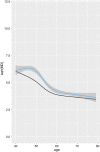Studying the association between longitudinal mammographic density measurements and breast cancer risk: a joint modelling approach
- PMID: 37296473
- PMCID: PMC10257295
- DOI: 10.1186/s13058-023-01667-8
Studying the association between longitudinal mammographic density measurements and breast cancer risk: a joint modelling approach
Abstract
Background: Researchers have suggested that longitudinal trajectories of mammographic breast density (MD) can be used to understand changes in breast cancer (BC) risk over a woman's lifetime. Some have suggested, based on biological arguments, that the cumulative trajectory of MD encapsulates the risk of BC across time. Others have tried to connect changes in MD to the risk of BC.
Methods: To summarize the MD-BC association, we jointly model longitudinal trajectories of MD and time to diagnosis using data from a large ([Formula: see text]) mammography cohort of Swedish women aged 40-80 years. Five hundred eighteen women were diagnosed with BC during follow-up. We fitted three joint models (JMs) with different association structures; Cumulative, current value and slope, and current value association structures.
Results: All models showed evidence of an association between MD trajectory and BC risk ([Formula: see text] for current value of MD, [Formula: see text] and [Formula: see text] for current value and slope of MD respectively, and [Formula: see text] for cumulative value of MD). Models with cumulative association structure and with current value and slope association structure had better goodness of fit than a model based only on current value. The JM with current value and slope structure suggested that a decrease in MD may be associated with an increased (instantaneous) BC risk. It is possible that this is because of increased screening sensitivity rather than being related to biology.
Conclusion: We argue that a JM with a cumulative association structure may be the most appropriate/biologically relevant model in this context.
Keywords: Breast cancer; Joint model; Longitudinal study; Mammographic density trajectory.
© 2023. The Author(s).
Conflict of interest statement
The authors declare that they have no competing interests.
Figures



Similar articles
-
Mammographic Density Change and Risk of Breast Cancer.J Natl Cancer Inst. 2020 Apr 1;112(4):391-399. doi: 10.1093/jnci/djz149. J Natl Cancer Inst. 2020. PMID: 31298705 Free PMC article.
-
Mammographic density measurements are not affected by mammography system.J Med Imaging (Bellingham). 2015 Jan;2(1):015501. doi: 10.1117/1.JMI.2.1.015501. Epub 2015 Mar 4. J Med Imaging (Bellingham). 2015. PMID: 26158085 Free PMC article.
-
Mammographic density-a review on the current understanding of its association with breast cancer.Breast Cancer Res Treat. 2014 Apr;144(3):479-502. doi: 10.1007/s10549-014-2901-2. Epub 2014 Mar 11. Breast Cancer Res Treat. 2014. PMID: 24615497 Review.
-
Mammographic density changes following BC treatment.Clin Imaging. 2021 Aug;76:88-97. doi: 10.1016/j.clinimag.2021.01.002. Epub 2021 Jan 12. Clin Imaging. 2021. PMID: 33578136
-
A Review of Breast Density Implications and Breast Cancer Screening.Clin Breast Cancer. 2020 Aug;20(4):283-290. doi: 10.1016/j.clbc.2020.03.004. Epub 2020 Mar 20. Clin Breast Cancer. 2020. PMID: 32334975 Review.
Cited by
-
Development and evaluation of a method to assess breast cancer risk using a longitudinal history of mammographic density: a cohort study.Breast Cancer Res. 2023 Nov 24;25(1):147. doi: 10.1186/s13058-023-01744-y. Breast Cancer Res. 2023. PMID: 38001476 Free PMC article.
-
Mammographic density by time and breast: a retrospective cohort study from BreastScreen Norway.Breast Cancer Res. 2025 May 16;27(1):83. doi: 10.1186/s13058-025-02037-2. Breast Cancer Res. 2025. PMID: 40380195 Free PMC article.
-
New diagnosis in psychiatry: beyond heuristics.Psychol Med. 2025 Feb 6;55:e26. doi: 10.1017/S003329172400223X. Psychol Med. 2025. PMID: 39911018 Free PMC article. Review.
References
Publication types
MeSH terms
LinkOut - more resources
Full Text Sources
Medical

